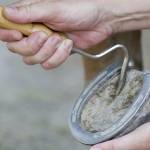Proper Care of Broodmare Hooves

Everyone has seen them…those older broodmares with big bellies, slightly saggy spines, tangled manes and tails, and hooves that could use a little more care. They’re worth keeping because of the foals they can produce, but that’s about all they have to do, so why put the time into sprucing them up?
While many broodmare owners and managers do take excellent care of their breeding stock, some seem to have the attitude mentioned above. It’s true that older broodmares don’t need to look as slick and polished as sales prospects, but there’s one aspect of their care that is vitally important to their comfort: proper hoof maintenance.
As broodmares reach the last few months of pregnancy, their weight increases, putting an extra-heavy load on their hooves. This stage of gestation often coincides with late winter when the footing in pastures is likely to be either deep and muddy or hard-frozen and rough-surfaced. Couple these things with a little arthritis, not uncommon in older mares, and you have a situation that can make late-pregnant mares quite uncomfortable.
Barefoot mares need regular trimmings to keep their hooves balanced and avoid spreading and splitting. Allowing hooves to become long and overgrown changes the angles of tendons and bones in the ankles, increasing strain. When hooves are trimmed after a long period of neglect, the proper angles are restored but the horse may be stiff and sore from the sudden readjustment. A schedule of trimming about every six weeks works well for many horses.
Some barefoot broodmares may be more comfortable with shoes as their weight increases in the last two or three months of pregnancy. A wide web shoe or heart bar shoe will increase support for the hoof. Shoes may also help mares avoid the soreness, bruises, and abscesses that can result from walking on frozen ground.
Whether mares are barefoot or shod, they should if possible not be scheduled for trims or resets very close to their foaling dates. Managers should attempt to set up farrier dates so that the last trim or reset comes several weeks before the foal is due, avoiding the stress of standing the mare on three legs when she is at her heaviest.








